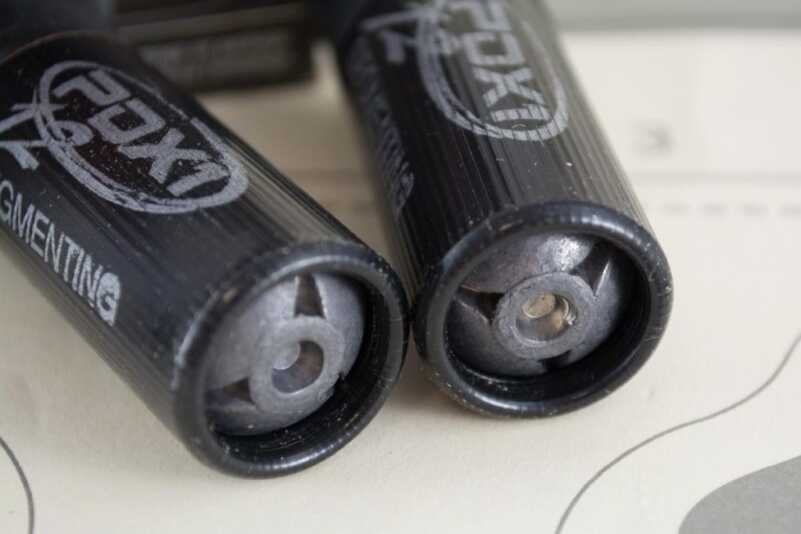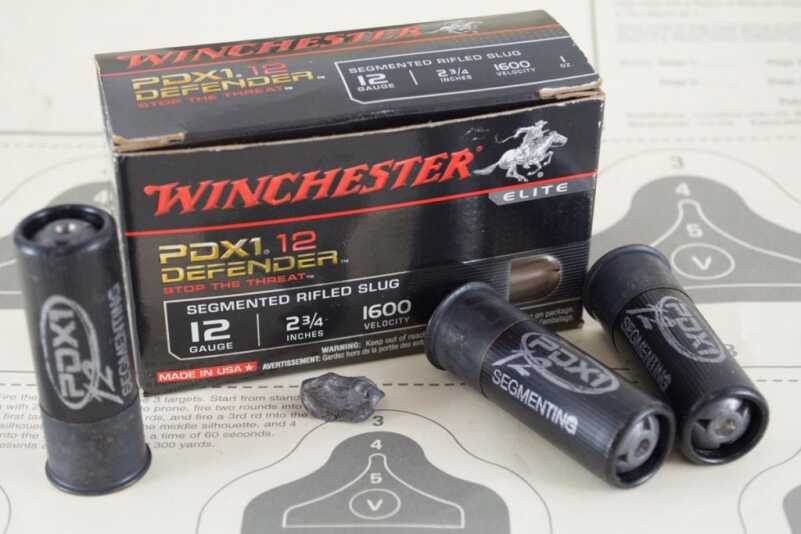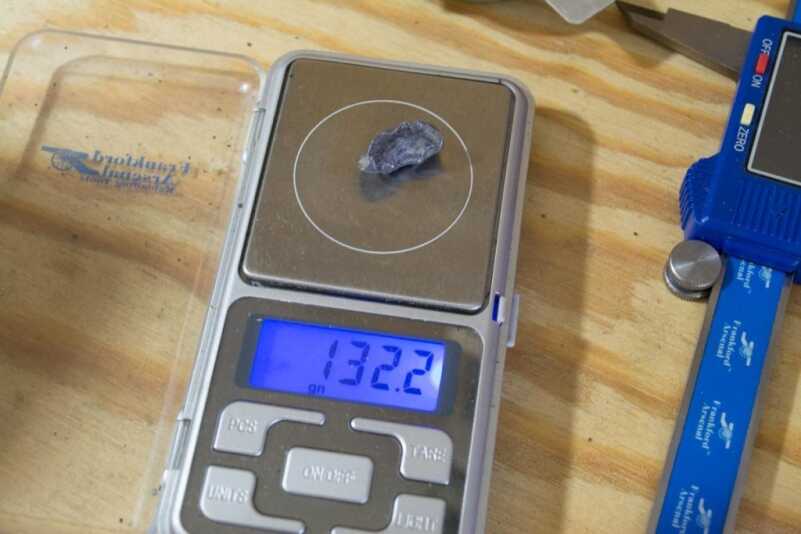For more information, visit https://winchester.com/Products/shotshell-ammunition/Innovative/PDX1-Defender-Shotshell/Pages/S12PDX1S.aspx.
What do you do if you don’t feel that a 12-gauge slug doesn’t have enough stopping power? OK, so maybe if you ever feel under gunned with a shottie slug you’re fighting Godzilla, but, hey, it could happen. You could try to stuff a 40mm grenade in there, but that requires all sorts of complicated licensing. A more realistic option might be to use a fragmenting projectile design. That’s exactly what Winchester Ammunition has done with their PDX1 Defender Segmenting Slug.
The PDX1 Defender brand umbrella covers a lot of territory. Early on, the line was comprised of a range of bonded pistol ammunition. Designed to expand reliably and retain its mass through tough barriers, it quickly gained a reputation for consistent performance across a wide range of handgun calibers. Over time, the PDX1 Defender family has expanded into rifle calibers and a series of innovative shotgun loads. For example, it’s the PDX1 Defender line that offers a .410 shotshell with a combination of disks and buckshot. Another load combines a slug with buckshot pellets. This one is all slug, but with a twist.

Note the specially designed shape and cuts in the slug. These cause it to fragment into three sections shortly after entering the target.
The theory of the Segmented Slug is that shortly after penetrating an organic target, the one-ounce slug will separate into three equal fragments. Each will veer off course to create it’s own separate wound channel. You get the impact of a one-ounce slug with the internal wounding capacity of three separate projectiles.
Let’s do some quick math on this. A one-ounce lead slug weighs 437.5 grains, or about the same as three heavy 9mm or light .40 S&W bullets. Think about that. Once the slug penetrates a few inches, it transforms into three handgun-sized projectiles, each plotting its own course through the target.
I wanted to see how this load worked, so I ran it through the basic ammo test protocol. I used my “go-to” defensive shotgun with this ammo. It’s a Beretta 1301 Tactical model. As a semi-automatic, recoil is greatly mitigated with hard-kicking slug and buckshot loads. More importantly, it’s a handy little shotgun for indoor use. The 18.5” barrel makes it compact and easy to maneuver. I’ve added an Urbino stock from Mesa Tactical. The pistol grip with shoulder stock offers a short length of pull, which also helps keep the overall package short and handy.
Winchester Ammunition rates the PDX1 Defender Segmenting Slug (12 gauge) at 1,600 feet per second. With its “almost as short as legally allowed” barrel, I expected the velocity from the Beretta 1301 to be somewhat less than that. To find out the actual, I set up a Shooting Chrony Beta Master Chronograph 15 feet down range, lined up carefully, and fired a series of the slugs through the screens. Average velocity worked out to 1,451 feet per second. The lowest I recorded zoomed by at 1,443 fps and the fastest clocked in at 1,458 fps. Given those results, I figure the factory number was measured using a 24 or 26-inch barrel.
Actual velocity isn’t really all that significant provided that the slugs do what they’re supposed to. And what is that exactly? The idea is that when the specially shaped and cut slug hits an organic target (liquid resistance), it breaks into three separate pieces. The design is intended to launch these three chunks of lead in diverging directions through the remainder of the target.

At three to four inches of penetration, the slug broke into three parts, each taking a different path through the gel block.
To get an idea of what that looks like, I pretty much destroyed a well-used Clear Ballistics 10% ballistic gelatin block. The company makes a variety of sizes and densities. This one was a 16-inch long and six by six-inch wide and tall model. To be on the safe side, I put another gel block behind it. If the pieces penetrated the entire block, at least I could see how much farther they traveled.
Here’s what happened. On impact, the entire block launched into the air a couple of feet due to the instantaneous and massive displacement of the Jello. Yes, that was pretty entertaining. When I went to inspect the results, I found that the slug entered as one solid projectile, as intended, and traveled about three inches into the gel as a solid piece. As you can see by the photo, a lot of chaos was going on as the slug started to break apart in the three to four-inch range. From that point on, three separate chunks of lead traveled in a three-corner pyramid pattern outward from the point of separation. Given the divergent flight paths, two of the chunks exited the side of the block and were lost to the woods. The third barely exited the 16-inch block and stopped against the leading edge of the backup gelatin block. Assuming the other two fragments had similar residual energy, penetration of the fragments was about 16 inches.

Two of the fragments were lost in space, but the third stopped against the backup gel block, meaning that penetration was exactly 16 inches.
When I got back to the office, I weighed the recovered fragment and found it to be 132.2 grains, or just a little less than one-third of the total 437.5-grain projectile weight. I would assume that the fragments don’t break into exactly identical pieces, so perhaps the other two were a little on the heavy side.
Unlike some of the fragmenting handgun wonder bullets, I think this idea has legs, mainly due to the mass involved. While many ultra-fragmenting handgun bullets have a reputation for under-penetration, that’s clearly not an issue when you’re starting with a 437.5-grain slug that breaks into three different 146-grain pieces. At the velocities involved, those will travel plenty deep.
The 12-gauge version of the PDX1 Defender Segmenting Slug is a standard 2 ¾-inch shell. You can also get a 20-gauge version. Besides the smaller bore, it contains a ¾-ounce (328-grain) slug so you might expect the fragments to weigh somewhere around 109 grains each. Still not too shabby, as each weighs a hair less than a standard 115-grain 9mm bullet.
For more information, visit https://winchester.com/Products/shotshell-ammunition/Innovative/PDX1-Defender-Shotshell/Pages/S12PDX1S.aspx.



I want 3 boxes
can i use the Winchester segmented rifled slugs in a smooth bore shotgun. It is a pistol grip Remington 870
Again with the clickbait. “Fragmentation grenade” means something specific to most of us here – “a metal casing around an explosive charge designed to inflict injuries by impact of shrapnel with the target’s body”. That’s not what this is.
But the concept and the way you describe it in the actual article are great. I was just thinking “Wow, does Winchester have a defense division again?” based on the headline. But I can see how three projectiles the same mass as .40 bullets hitting an attacker might get his attention.
Not sure what you’re referring to. The term “fragmentation grenade” is not used anywhere in this article…
I damn sure wouldn’t want to be on the receiving end of any of them
I load the old Winchester PDX1 .12 gauge shells (1 oz slug + 3 #00 buckshot) in my Mossberg 930 SPX. I mix them with a few Herter’s loads (2 round balls and 1 ball + 6 #1 shot) and a 9 pellet #00 buck round. Capacity is 8, so I get 2 of each before reloading. If that does not stop a home invasion, I hope it will at least buy me time to access a Modern Sporting Rifle!
What ever floats your boat, to me 9 .33 rd. balls would be kind of like being nailed by a sub machine gun.
the gimmicks just keep a comin